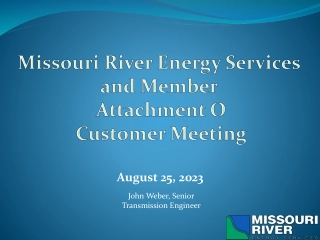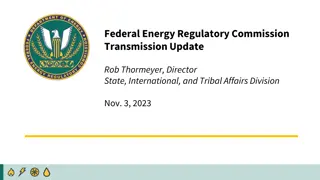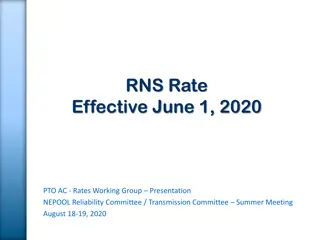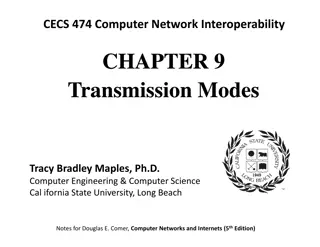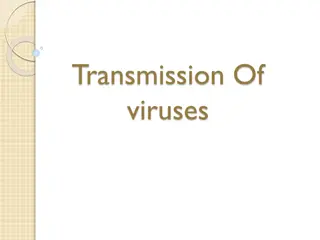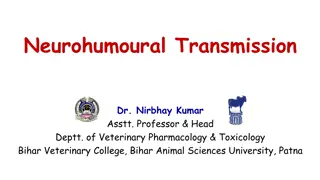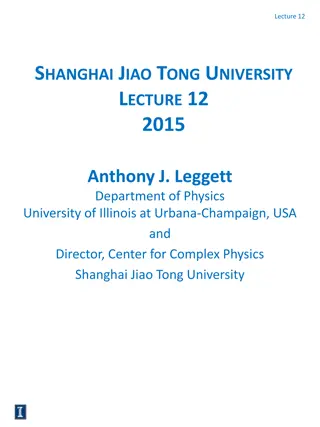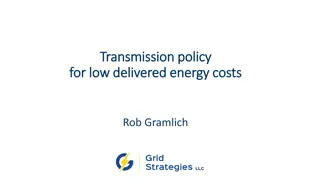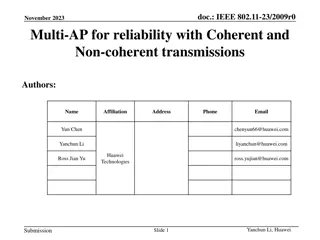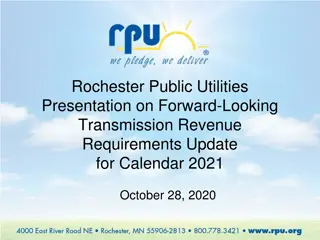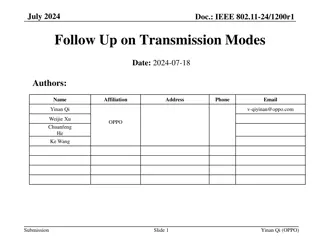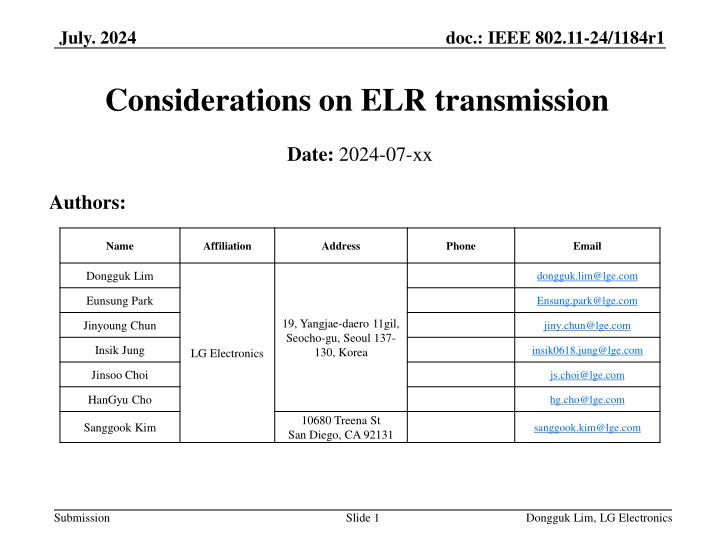
Investigation on ELR Transmission Considerations in IEEE 802.11-24/1184r1
Explore the considerations for enhanced long-range (ELR) transmission within IEEE 802.11-24/1184r1, focusing on addressing link budget imbalances and legacy preamble impacts. Options for ELR transmission methods, coexistence with legacy devices, and performance evaluations are discussed.
Download Presentation

Please find below an Image/Link to download the presentation.
The content on the website is provided AS IS for your information and personal use only. It may not be sold, licensed, or shared on other websites without obtaining consent from the author. If you encounter any issues during the download, it is possible that the publisher has removed the file from their server.
You are allowed to download the files provided on this website for personal or commercial use, subject to the condition that they are used lawfully. All files are the property of their respective owners.
The content on the website is provided AS IS for your information and personal use only. It may not be sold, licensed, or shared on other websites without obtaining consent from the author.
E N D
Presentation Transcript
July. 2024 doc.: IEEE 802.11-24/1184r1 Considerations on ELR transmission Date: 2024-07-xx Authors: Name Affiliation Address Phone Email Dongguk Lim dongguk.lim@lge.com Eunsung Park Ensung.park@lge.com 19, Yangjae-daero 11gil, Seocho-gu, Seoul 137- 130, Korea Jinyoung Chun jiny.chun@lge.com Insik Jung insik0618.jung@lge.com LG Electronics Jinsoo Choi js.choi@lge.com HanGyu Cho hg.cho@lge.com 10680 Treena St San Diego, CA 92131 Sanggook Kim sanggook.kim@lge.com Submission Slide 1 Dongguk Lim, LG Electronics
July. 2024 doc.: IEEE 802.11-24/1184r1 Introduction The ELR (i.e. enhanced long range) was proposed at the previous F2F meeting to solve link budget imbalance caused by the difference TX power between AP and non-AP STA.[1-3] In this contribution, we investigate consideration points on ELR transmission concerning the impact of the legacy preamble. Submission Slide 2 Dongguk Lim, LG Electronics
July. 2024 doc.: IEEE 802.11-24/1184r1 ELR transmission (1/2) Based on presented contributions[1~3], we can consider several options for ELR transmission. The following transmission methods may be considered to achieve the minimum data rate proposed as 1.5Mbps or a slightly higher rate as well as the link budget gain. For the simple design and low complexity, existing RU and MCS are considered. Option 1 - Three times repetition of 52 tone RU Repeated RU 52 tone RU1 52 tone RU2 52 tone RU3 52 tone RU4 Option 2 Repetition of 106 tone RU with MCS 15 106 tone RU1 with MCS 15 106 tone RU2 with MCS15 Submission Slide 3 Dongguk Lim, LG Electronics
July. 2024 doc.: IEEE 802.11-24/1184r1 ELR transmission (2/2) Also, as shown in [1], to support the coexistence with legacy STA, the ELR PPDU should include the legacy preamble. Example of ELR PPDU format in [1] Legacy Preamble ELR Preamble ELR Data There have been a lot of discussions about the impact of the legacy preamble such as range imbalance, packet detection, etc., and we checked first whether the legacy preamble was a performance bottleneck in case the range extension gain from ELR transmission might not be fully guaranteed. Herein, RL-SIG, U-SIG repetition, and two options described in the previous slide are used to evaluate the ELR transmission. Submission Slide 4 Dongguk Lim, LG Electronics
July. 2024 doc.: IEEE 802.11-24/1184r1 Performance evaluation (1/2) Simulation parameters. 5GHz Band 20MHz bandwidth 1000 data bits SISO MCS0 with BCC Channel B NLoS and D NLoS Real Channel estimation with CFO and TO ELR transmission with 3 times repetition of 52 tone RU/ repetition of 106 tone RU with MCS 15 3dB power boosting in L-STF and L-LTF RL-SIG and U-SIG repetition defined in ER preamble were considered. Submission Slide 5 Dongguk Lim, LG Electronics
July. 2024 doc.: IEEE 802.11-24/1184r1 Performance evaluation (2/2) The performance of L-SIG and U-SIG at 1% PER is worse than the performance of the data field at 10% PER. Therefore, we need to consider a similarly guaranteed link margin gain in the SIG field as well as an enhancement in the data field. Note : The performance of L-SIG means the performance of combined L-SIG and RL-SIG, The performance of U-SIG means the performance of repeated U-SIG as described in ER preamble. Submission Slide 6 Dongguk Lim, LG Electronics
July. 2024 doc.: IEEE 802.11-24/1184r1 Considerations for ELR (1/2) To supplement the performance gap due to the SIG field, the following method can be considered. Method 1: ELR transmission based on TB PPDU. To address the range imbalance between the SIG field and ELR data field, ELR transmission may be applied only to trigger-based UL transmission in UHR, so the SIG field may not have a significant impact on the range aspect. The 3dB power boosting can be applied to L-STF and L-LTF of TB PPDU for ELR In ELR transmission performed based on TF, the SIG field information of the ELR PPDU is already known to the AP, so SIG field performance may not be an obstacle from the AP reception aspect. In addition, the ELR transmission can be protected through the trigger frame transmitted by AP in an AP coverage. Submission Slide 7 Dongguk Lim, LG Electronics
July. 2024 doc.: IEEE 802.11-24/1184r1 Considerations for ELR (2/2) Method 2 : New PPDU with enhanced performance of the SIG fields. The ELR PPDU can be designed to provide the improved range of the SIG field, just like a data field. As a simple way for that, the symbol repetition in time domain can be considered. For example, the L-SIG field in the ELR PPDU can be repeated more than 2 times to improve the performance. By applying more repetitions, we can achieve the enhanced range of the L-SIG field as shown in the appendix while it is insignificant to increase overhead in the ELR transmission. Though the repetition of the L-SIG symbol does not affect on the packet classification of legacy STA, to obtain the combined gain from this extension, this PPDU format should be detected before receiving the L-SIG field when this PPDU is received. For that, as described in [3], the packet detection of this PPDU may be performed by using the L-STF that needs further discussion. Submission Slide 8 Dongguk Lim, LG Electronics
July. 2024 doc.: IEEE 802.11-24/1184r1 Summary In this contribution, we evaluated the performance gap between the L-SIG and the data field designed for ELR when the legacy preamble is included in ELR PPDU. The performance of L-SIG(with RL-SIG) and U-SIG(w/ repetition) at 1% PER is worse than the performance of a data field for ELR at 10%. To reduce the impact of the legacy preamble, we propose to consider following ways for ELR transmission. Option 1 : ELR transmission based on the TF Option 2 : Design of new ELR PPDU format to overcome the range imbalance on legacy SIG fields. Submission Slide 9 Dongguk Lim, LG Electronics
July. 2024 doc.: IEEE 802.11-24/1184r1 Straw poll 1 Do you agree that ELR PPDU starts with a legacy preamble in the PPDU for the ELR transmission? The legacy preamble contains the L-STF, L-LTF, L-SIG, RL-SIG, and U-SIG. Yes No Abstain Submission Slide 10 Dongguk Lim, LG Electronics
July. 2024 doc.: IEEE 802.11-24/1184r1 Straw poll 2 Which option do you prefer for ELR transmission to solve the range imbalance between the SIG field(e.g., L- SIG/U-SIG) and ELR data field of the transmission methods described on slides 7-8? Option 1: ELR transmission based on TB PPDU Option 2: Design of new ELR PPDU format with improvement of legacy preamble Option 3: Need more study. Submission Slide 11 Dongguk Lim, LG Electronics
July. 2024 doc.: IEEE 802.11-24/1184r1 Straw poll 3 Do you agree to include the following text to the 11bn SFD? In ELR transmission, a method of transmitting a RU smaller than a 242-tone RU, with a repetition(s) in frequency domain within 20MHz, is used. The details are TBD Y N Abstain Submission Slide 12 Dongguk Lim, LG Electronics
July. 2024 doc.: IEEE 802.11-24/1184r1 Straw poll 4 Which option do you prefer to obtain the link budget gain in ELR transmission? Option 1: Three times repetition of 52 tone RU Option 2: Repetition of 106 tone RU with MCS 15 Option 3: Need more study. Submission Slide 13 Dongguk Lim, LG Electronics
July. 2024 doc.: IEEE 802.11-24/1184r1 Appendix The performance of L-SIG with 2 repetition Submission Slide 14 Dongguk Lim, LG Electronics
July. 2024 doc.: IEEE 802.11-24/1184r1 Appendix Packet classification 11a L-STF L-LTF L-SIG DATA 11n MM L-STF L-LTF L-SIG HT-SIG1 HT-SIG2 HT-STF HT-LTFs DATA VHT- SIGA1 VHT- SIGA2 VHT- LTFs VHT- SIGB 11ac L-STF L-LTF L-SIG VHT-STF DATA 11ax SU/MU HE- SIGA1 HE- SIGA2 L-STF L-LTF L-SIG RL-SIG HE-SIGB HE-STF HE-LTFs DATA HE- SIGA1 HE- SIGA1' HE- SIGA2 HE- SIGA2' 11ax ER L-STF L-LTF L-SIG RL-SIG HE-STF, HE-LTF, DATA 11be MU L-STF L-LTF L-SIG RL-SIG U-SIG1 U-SIG2 EHT-SIG ETE-STF ET-LTFs DATA HT-MM : LENGTH%3 == 0 + HT-SIG1 QBPSK + HT-SIG2 QBPSK VHT : LENGTH%3 == 0 + VHT-SIG1 BPSK + VHT-SIG2 QBPSK HE SU/MU : LENGTH%3 ~= 0 +RL-SIG + HE-SIGA1 BPSK + HE-SIGA2 BPSK HE ER SU : LENGTH%3 ~= 0 +RL-SIG + HE-SIGA1 BPSK + HE-SIGA2 QBPSK EHT MU PPDU : LENGTH%3 = 0 + RL-SIG + U-SIG1 BPSK+ U-SIG2 BPSK + PHY identifier field = 0 Submission Slide 15 Dongguk Lim, LG Electronics
July. 2024 doc.: IEEE 802.11-24/1184r1 Reference [1] 11-24-0873-00 Design Targets and Considerations for Enhanced Long Range [2] 11-24-0875-01 UHR Enhanced Long Range Support [3] 11-24-0921-00 An Enhanced Long Range PPDU Submission Slide 16 Dongguk Lim, LG Electronics

